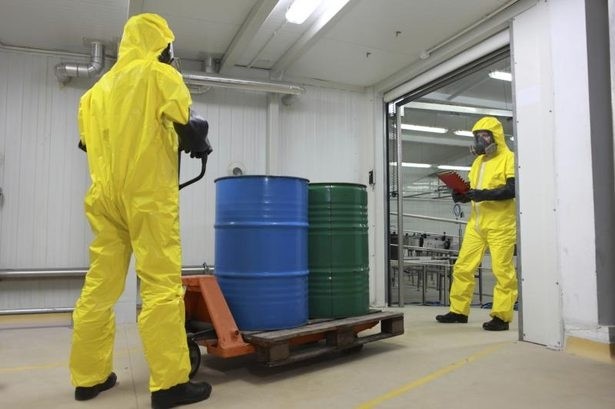Chemical Safety Tips For The Workplace

Many modern industries and workplaces use chemicals for things as mundane as cleaning the windows and as exotic as manufacturing dangerous compounds like sulfuric acid. Whatever the hazards are, always be aware of basic safety precautions and accident prevention.
Spill Cleanup
Depending on your workplace and the chemical involved,cleaning up a spill can be as simple as wiping up after a knocked-over water bottle. But more serious spills demand more serious cleanups. Basic cleanup kits consisting of rubber gloves, highly absorbent pads, and an absorbent silica material (even kitty litter works for many low-hazard substances) should be readily available. More hazardous substances will have special requirements, such as containment of contaminated absorbent silica, or special chemicals for substances like mercury, which regular silica or sand cannot absorb.
Material Safety Data Sheets
Reading material safety data sheets (MSDS) before handling a chemical is an excellent way to familiarize yourself with all its hazards and properties. Data sheets contain hazard ratings for flammability, corrosiveness, reactivity (a measure of how readily and violently a chemical releases energy during reactions) and contact rating.
Personal Protective Equipment
Having the right safety equipment is important to maintaining a safe workplace. Personal protective equipment refers to any piece of gear or clothing used to mitigate a hazard. Goggles, gloves and a lab coat are standard fare in most laboratories, but protective gear also includes respirator masks and oxygen tanks used in confined spaces, or hazmat suits.
Fire Safety
Most fires can be extinguished with standard carbon dioxide extinguishers. These are excellent for quickly cutting off a fire from the oxygen it needs to burn, but they will not work in all cases. Typically, metal and grease fires require special dry-powder extinguishers, which use a chemical powder specifically engineered to quell irregular chemical reactions, or fires that would be exacerbated by water, such as grease fires.
Response Plan
Response plans for a chemical emergency should always be in place and understood by all employees long before an accident occurs. All employees should know what to do during an emergency, especially if they are part of a response team. Others should know they simply need to evacuate and meet at a safe point.
Spill Cleanup
Depending on your workplace and the chemical involved,cleaning up a spill can be as simple as wiping up after a knocked-over water bottle. But more serious spills demand more serious cleanups. Basic cleanup kits consisting of rubber gloves, highly absorbent pads, and an absorbent silica material (even kitty litter works for many low-hazard substances) should be readily available. More hazardous substances will have special requirements, such as containment of contaminated absorbent silica, or special chemicals for substances like mercury, which regular silica or sand cannot absorb.
Material Safety Data Sheets
Reading material safety data sheets (MSDS) before handling a chemical is an excellent way to familiarize yourself with all its hazards and properties. Data sheets contain hazard ratings for flammability, corrosiveness, reactivity (a measure of how readily and violently a chemical releases energy during reactions) and contact rating.
Personal Protective Equipment
Having the right safety equipment is important to maintaining a safe workplace. Personal protective equipment refers to any piece of gear or clothing used to mitigate a hazard. Goggles, gloves and a lab coat are standard fare in most laboratories, but protective gear also includes respirator masks and oxygen tanks used in confined spaces, or hazmat suits.
Fire Safety
Most fires can be extinguished with standard carbon dioxide extinguishers. These are excellent for quickly cutting off a fire from the oxygen it needs to burn, but they will not work in all cases. Typically, metal and grease fires require special dry-powder extinguishers, which use a chemical powder specifically engineered to quell irregular chemical reactions, or fires that would be exacerbated by water, such as grease fires.
Response Plan
Response plans for a chemical emergency should always be in place and understood by all employees long before an accident occurs. All employees should know what to do during an emergency, especially if they are part of a response team. Others should know they simply need to evacuate and meet at a safe point.
- 4952af9e02ff5b54da954b87b76a0e4f04.jpg